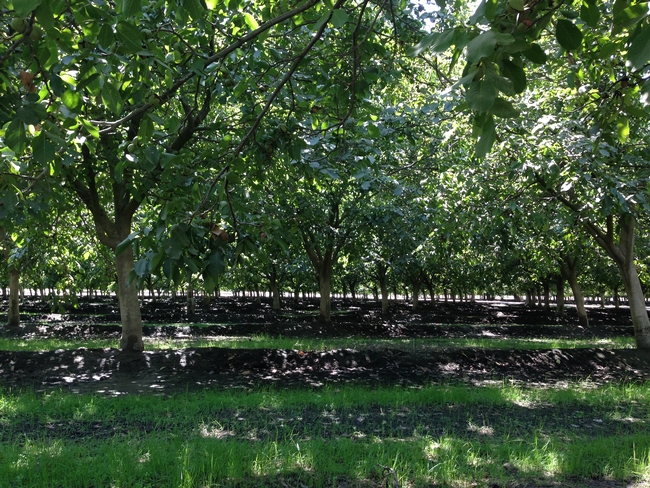- Author: Elizabeth J Fichtner
- Author: Santosh Bhandari
- Author: Jennifer Randall
- Author: Richard Heerema
Walnuts and pecans represent two of the four major nut crops grown in California. The California walnut industry dwarfs the state's pecan industry in acreage, with over 300,000 acres dedicated to commercial walnut production and approximately 3,000 acres to pecan. The relatedness of the two crops has facilitated an overlap of specialization in the grower community, with many long-time walnut growers also managing the state's pecan acreage.
Walnuts and pecans are both in the same plant family (Juglandaceae); consequently, they have similar reproductive habits. They are both monoecious, meaning that male and female flowers are borne on the same tree. Also, both pecan and walnut produce male flowers called ‘catkins' (Figure 1), and the non-showy female flowers are produced at the terminus of a preformed shoot (Figure 2) that emerges from a compound bud. On walnuts, the catkin buds are visible at nodes, sometimes with two catkins occupying a single node as a primary and secondary bud (Figure 1A). Conversely, the catkin buds on pecan are not readily visible before bud break (Figure 1B). During the delayed dormant phase on pecan, the catkins are hidden behind a scale sheath that covers the catkins and compound shoot bud (Figure 1 B and C). As a result, the catkins only emerge as the entire bud assemblage pushes, generally in late March-early April in California. The compound bud, containing the current season's shoot and female flowers, is assembled with catkins that emerge in groups of three (Figure 1C and 2B). As a result, groups of catkins mature at the base of the current season's shoot (Figure 2B).
The compound buds of walnut and pecan are similar in that the bud contains the preformed shoot and preformed leaves as well as the female (pistillate) flowers. The female flowers are located at the apex of the preformed shoot (Figure 3 A and B). Walnuts and pecans both have variable numbers of pistillate flowers in each compound bud. Walnut flowers are readily visible with the naked eye, whereas pecan flowers are smaller, and observation of the stigmatic surface may be enhanced with the aid of a hand lens. The final nut set of each compound bud varies based on the number of initial pistillate flowers and the success of pollination and fertilization processes.
Both walnut and pecan tend to exhibit apical dominance as evidenced by the stronger, and often earlier, growth of the apical bud. In walnut, two buds (primary and secondary) may be present at each node. Usually, one bud will dominate and grow, while the weaker bud will remain static or die off. Occasionally, both primary and secondary buds grow, resulting in branching at acute angles, often referred to as “forking”. In walnut, nut set can be evaluated by early June and buds for the next year's crop may already be visible in May (Figure 4A). In vigorous orchards, in-season growth may be produced beyond the position of the nuts (Figure 4B). In-season (neoform) growth is less common in pecan. Researchers speculate that the neoform growth observed in walnut may be related to the use of vigorous hybrid rootstocks.
Although pecan and walnut are related species hailing from the same plant family, their growth and reproductive habits do have notable differences. Growers with a lifetime of experience with walnuts may be baffled by the lack of visible catkins on pecan during the dormant season. A bit of patience in the spring, however, reveals the reproductive structures upon bud break. The need for patience in pecan cultivation is also notable at harvest time. In California, the pecan harvest generally commences after the walnut harvest is complete and often continues into the successive year as fall rain events may impede orchard access.
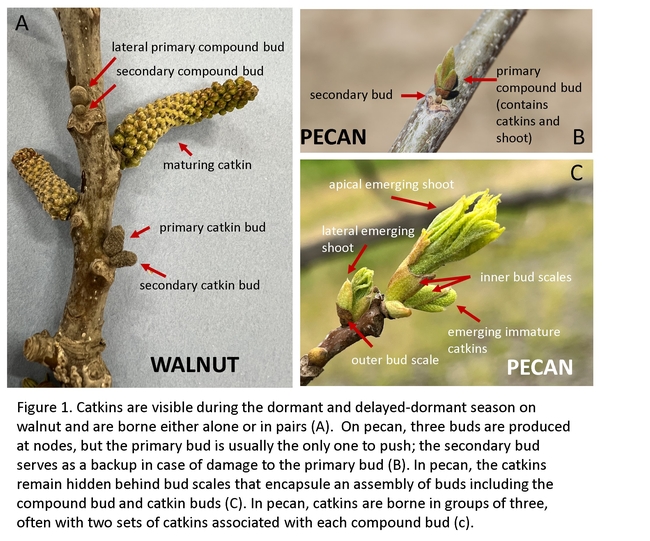
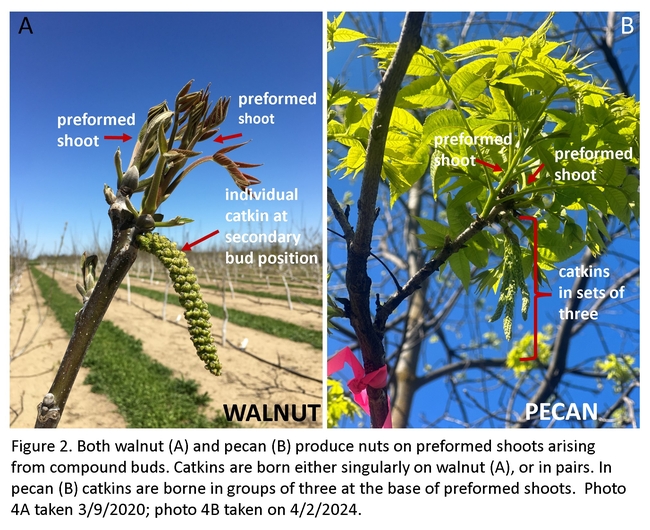
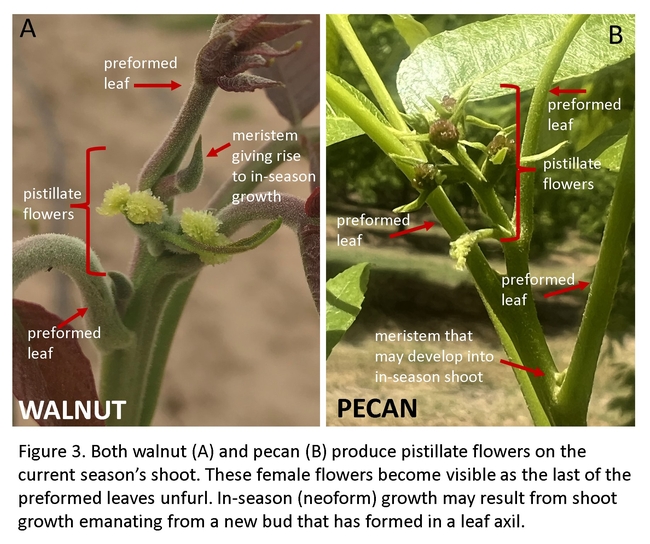
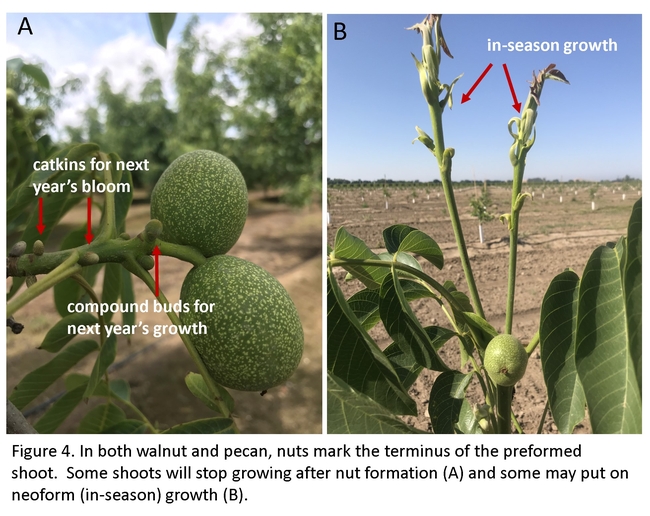
- Author: Raymond Mireles
- Author: Mohammad Yaghmour
- Author: Santosh Bhandari
- Author: Elizabeth J Fichtner
Within the past decade a wood decay fungus with no prior record in North America has emerged as a pathogen of almond, prune, and peach (rootstock) in the San Joaquin Valley. Since 2016, Ganoderma adspersum, has been associated with decay symptoms on almonds in Kings, Tulare, Kern, and Madera counties. Unlike other endemic species of Ganoderma that were previously recognized in California almond orchards, G. adspersum appears to be aggressive on young trees, particularly those on ‘Nemaguard' rootstock. Additionally, G. adsperum infection appears to be prevalent in orchards with high incidence of crown gall caused by Agrobacterium tumefaciens, leading plant pathologists to suspect that the bacterial disease may predispose infected almond trees to the decay fungus. After a recent farm call with almond growers and crop consultants, UCCE Advisors Mohammad Yaghmour, Elizabeth Fichtner, and Raymond Mireles have initiated a series of studies to further investigate the potential relationship between crown gall and G. adspersum in the field, as well as evaluate techniques to limit the spread of G. adspersum in orchards.
Ganoderma adspersum is a wood decay fungus that infects the roots and butts of trees causing white rot and leading to tree blow-over and mortality especially after windy and rainy storms, hence, it is also called butt rot. Infected trees may appear healthy but are more likely to collapse during storms or harvest activities than uninfected trees.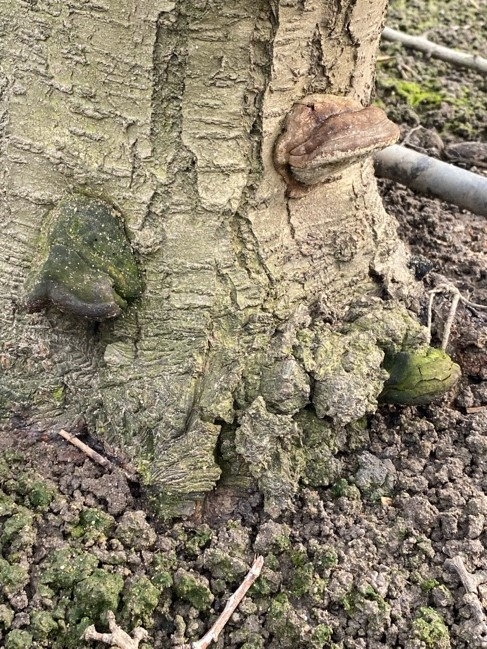
In February 2024, Yaghmour, Fichtner, and Mireles established new research studies in Tulare County orchards to address the hypothesis that G. adspersum infections are more prevalent on trees infected with A. tumefaciens. With the assistance of Santosh Bhandari, Associate Specialist with UC ANR, over 6,000 trees were surveyed across two orchards and rated for incidence of each disease. Both orchards were on ‘Nemaguard' rootstock and included ‘Nonpareil,' ‘Monterey,' and ‘Fritz' varieties. Results of statistical analyses indicate a significant association between G. adspersum and crown gall infection on all varieties in both orchards. For each incident of crown gall, the probability of infection with G. adspersum increased by over 80-fold across all varieties in both orchards.
Studies conducted by Daisy Hernandez, a PhD student in the Department of Plant Pathology at UC Davis, suggest that stem infections with crown gall do not alter the tree's susceptibility to future infection with G. adspersum at another location on the stem. This work suggests that the association of the two diseases may not be related to a physiological change in the plant resulting from prior infection with A. tumefaciens; however, it does not rule out other mechanisms of predisposition. Mireles, Yaghmour, and Fichtner are interested in studying whether the crown gall itself presents a unique infection court (ie. opening) that facilitates infection with windblown spores of G. adspersum that may encounter the gall years after crown gall development.
In 2024, new studies will be initiated to evaluate the potential benefit of phosphites (ie. K-Phite®) in limiting the progression of new infections of G. adspersum in affected almond orchards. Phosphites offer a cost-effective approach at managing several plant diseases, including Phytophthora on almonds. Phosphites are known to induce plant defense responses to disease and are often better at preventing than curing disease. Additionally, some growers have expressed interest in using conk-removal as a strategy for reducing G. adspersum inoculum in orchards. UCCE Advisors plan to evaluate the influence of phosphite treatment on the rate of fruiting body regrowth with the anticipation of identifying multiple techniques that growers may employ to mitigate the economic effects of these diseases in California orchards.
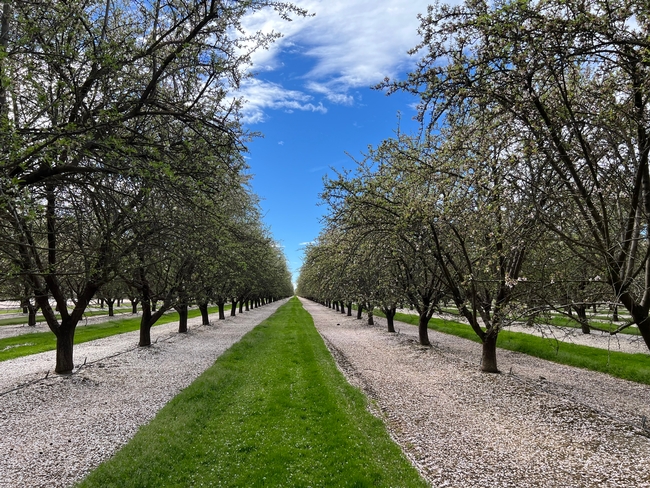
- Author: Santosh Bhandari
- Author: Laurel Hoffman
- Author: Elizabeth J Fichtner
Recently, extensive wood decay-related limb breakages have been reported in commercial prune orchards in the Sacramento Valley, adversely affecting fruit production and limiting the value of salable firewood upon orchard removal. Several fungal genera such as Phellinus, Rhodoformes, Schizophyllum, Sterum, Trametes, Ceriporia, and Perenoporia have been recognized for wood-decaying activity on California prunes. Phellinus pomaceus has been the primary organism associated with prune decay symptoms in the Sacramento Valley; however, it is yet unknown whether P. pomaceus is present in southern San Joaquin Valley prune orchards.
Phellinus pomaceus, specific to prunes and other plums, is one of the commonly reported wood-decaying fungi that attack the heartwood (non-functional xylem) of mature trees (Figure 1). It tends to attack the trunk and large-diameter branches, often resulting in broken limbs and the loss of fruit-bearing scaffolds. In fact, older trees are more likely to contain infection by the fungus, and frequent pruning of large branches may increase the probability of infection due to exposure of the internal heartwood. The fungus can be identified based on its fruiting bodies that emerge as conks or shelf-like brackets that are usually hard, woody, and hoof-shaped (Figure 2). Under the right conditions, these fruiting bodies are often perennial and may exhibit a darkened upper surface after several years of development.
UCCE Tulare County assisted UC Davis researchers from the Department of Plant Pathology in surveying Tulare County prune orchards for presence of P. pomaceus. Laurel Hoffman, a PhD student working under Dave Rizzo, Professor of Plant Pathology, visited our local UCCE Tulare County office, coordinating with Elizabeth Fichtner, UCCE farm advisor, to visit and survey prune orchards for the pathogen. With the assistance of Walter Martinez, Tulare County Ag Technician, and Santosh Bhandari, Assistant Specialist, six local ‘French' prune orchards were surveyed with data collected on tree canopy status and presence or absence of fruiting bodies associated with decay fungi. Surveyed orchards were all over 15 years old and were in varying states of overall productivity. Samples from putative decay fungi were collected and brought back to UC Davis for genetic sequencing to identify the specimens. A preliminary observation based on the initial survey suggests that the prevalence of putative decay fungi in prune orchards is lower in the southern San Joaquin Valley than in the Sacramento Valley. The presence of P. pomaceus in the southern San Joaquin Valley has not yet been confirmed.
To date, there are no control measures for management of P. pomaceus. Chemical control strategies are not available for management of this disease. Removal of fruiting bodies may limit sporulation, thus having the potential to slow disease transmission. However, the value of this technique is limited by the ability to remove conks prior to sporulation and conks may be difficult to see, particularly after leaf out. Additionally, if the pathogen is present at a high level in (or near) affected orchards, the removal of conks may not significantly influence the total load of spores at a site. Fruiting body removal would not affect the health of infected trees because they are already colonized by the fungus.
Most of California's prunes are sold in the dried fruit market; however, a few orchards are reserved for fresh prune production. After the economic lifespan of prune orchards, trees are removed, generating wood that can either be sold as firewood, or reintroduced to the soil through whole orchard recycling. Infection with decay fungi such as P. pomaceous may adversely affect fruit production, limit the lifespan of infected trees, and reduce the economic longevity of orchards.
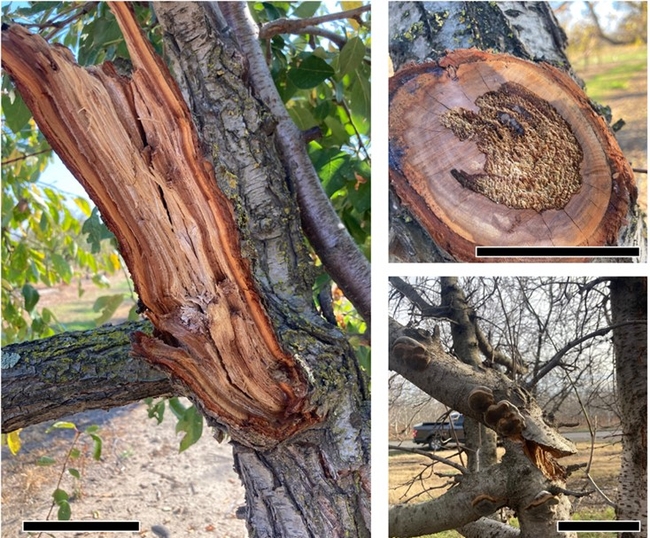
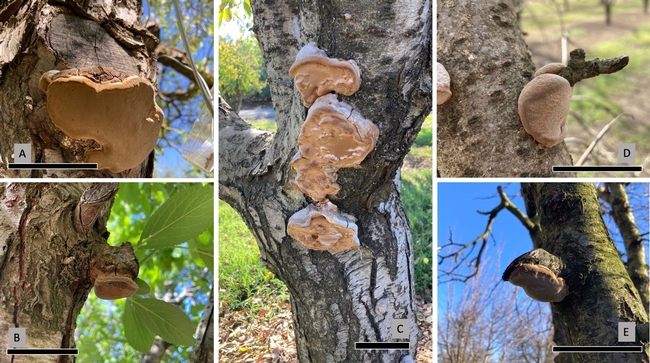
- Author: Santosh Bhandari
- Author: Elizabeth J Fichtner
The 2024 Statewide Pistachio Day attracted over 600 attendees to the Visalia Convention Center on January 17, 2023. This annual event is designed to extend research conducted by University of California scientists to the growers, ranch managers, PCAs, and other members of allied industries, who translate the information into tangible practices affected production.
The 2024 meeting was hosted by Elizabeth Fichtner, Farm Advisor, UCCE Tulare County and David Haviland, Farm Advisor, Kern County. The event was divided into three sessions moderated by Jorge Angeles, Farm Advisor UCCE Tulare County, Tobias Oker, Farm Advisor UCCE Kern County, and David Haviland, Farm Advisor UCCE Kern County. Coffee, breakfast, and luncheon were sponsored by the California Pistachio Research Board and numerous corporate sponsors.
Robert Klein, manager of the California Pistachio Research Board, provided updates from the California Pistachio Research Board on pistachio production and consumption. During the morning session, researchers from the University of California provided information on different aspects of pistachio culture including economics, climatic considerations, breeding, fertility, cover cropping, satellite remote sensing, and mechanical harvesting. The afternoon session focused on pest management issues, including disease and insect management, as well as nematode management. Researchers discussed implementation of sterile insect technique for management of navel orangeworm, monitoring programs for leaffooted bug, insecticide programs for Gill's mealybug and insights on Carpophilus, a recently-identified pest in California. During the coffee and luncheon breaks, participants interacted with the sponsors hosting booths in the trade show area. The event concluded with a Pest Management Question and Answer session that facilitated conversation between researchers and the grower and PCA communities.
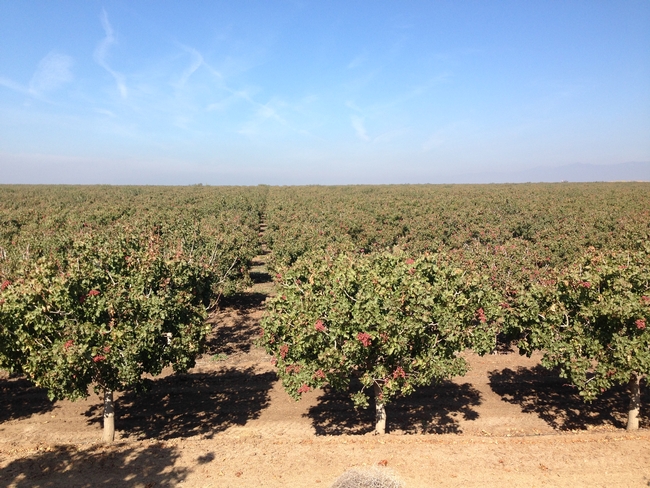
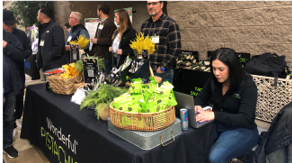
- Author: Santosh Bhandari
- Author: Elizabeth J Fichtner
Over the past few years, the California walnut industry has experienced several challenges including supply-chain disruptions due to the COVID-19 pandemic, a pronounced heatwave in September 2022 that affected walnut quality throughout the state, and the introduction and growth of international producers in the global walnut market. Recently, Tulare County had more walnut acreage removed than any other county, and statewide walnut acreage declined by around 30,000 acres. Despite the decline in acreage, the 2023 season resulted in a record walnut crop in California.
Addressing grower and industry concerns, UCCE Tulare County hosted the 52nd Tri County Walnut Day on February 1st, 2024, the second in-person meeting since the pandemic. The event attracted approximately 60 walnut growers and members of allied industries. The program was organized by Elizabeth Fichtner, UCCE Tulare County Farm Advisor, and moderated by Raymond Mireles, a new fresh fruit and almond advisor at the UCCE Tulare County office, as well as Caleb Crawford, a Staff Research Associate at UCCE Tulare County. The morning coffee was sponsored by Jason Scott Marketing (West Coast Nut Magazine), and the luncheon was provided by the California Walnut Board and Commission.
Elizabeth Fichtner, a farm advisor at UCCE Tulare County, initiated the program with a short welcome speech and gave her talks on walnut scale and frosted scale management, and minimal heading of Ivanhoe, a new variety of walnut with large, light-colored kernels and high yields. Themis Michailides, professor at UC Davis, presented on the mold problems of walnut and its association with nut quality. Another highlight was the presentation by Bob Beede, Farm Advisor Emeritus of UCCE Kings County, on the management of input costs during low-price years. Other topics covered by University of California researchers included weed management, walnut quality issues, rootstock selection, and pest management. Robert Verloop, Executive Director and CEO of the California Walnut Board and Commission provided updates about the increased production of walnut but flat consumption trends worldwide. The California Walnut board, established in 1948, is funded by mandatory assessments of walnut handlers while the California Walnut Commission, established in 1987, is funded by mandatory assessments of growers. A panel discussion, moderated by Mr. Verloop, was held to facilitate discussion between handlers, growers, and allied industry members.
